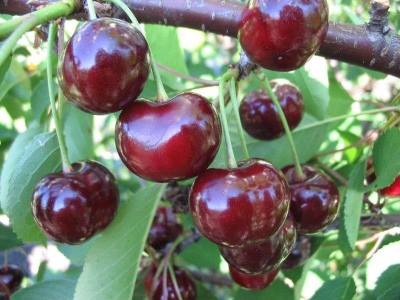
- Authors: Rossoshan Experimental Gardening Station
- Barrel type: wood
- Growth type: medium-sized, vigorous
- Crown: round, slightly raised, thick
- Leaves: medium-sized glossy
- Flowers: medium size
- Flowering and fruiting type: on last year's shoots
- Fruit size: average
- Fruit shape: rounded
- Fruit color: dark cherry
One of the most productive cherry subspecies today is the technical variety Prima. The culture was obtained, like many other successful varieties, at the Rossoshan experimental gardening station, known to many summer residents.
Description of the variety
Cherry Prima develops in a tree-like form, the plant is medium-sized, can reach a height of 3.5 m. The crown has the shape of a ball, while it is quite dense. The berries ripen on last year's sprouts.
Fruit characteristics
Medium-sized cherries typically weigh 3-4 grams. They are distinguished by their rounded shape, dark cherry skin, and dark red flesh. The bone, which is well separated from it, is of medium size.
Taste qualities
The flesh of the cherry is quite dense, sweet, sour, juicy, very pleasant to the taste. The juice has the same color as the pulp - dark red. Given the technical purpose, the fruits are most often processed for different types of homemade products. And they succeed in this: all the delicacies are very tasty and aromatic.
Ripening and fruiting
Prima belongs to the group of cherry crops with a late ripening period, its fruiting approximately falls on the last 5 days of July. A distinctive feature of the variety is that the fruits of the described cherry can hang on the branches for a long time after ripening, until the first autumn month, while not losing gastronomic qualities. Berries do not suffer from the sun, keeping their presentation.

Yield
Prima is a high-yielding cherry variety. Average yield from one tree is 20-25 kg, the maximum harvest can reach 84 kg of fruits.
Growing regions
Cherry Prima grows comfortably in harsh climates. It tolerates heat well, prolonged drought, severe frosts, and snowy winters. Thanks to these qualities, the culture is grown in absolutely all regions of the country.
Self-fertility and the need for pollinators
The culture is self-fertile. Pollinators of Prima can be other cherry varieties, such as:
- Vladimirskaya;
- Lyubskaya;
- Shubinka.
Landing
Basically, the planting of culture is carried out in the spring, and for this it is better to use seedlings at the age of 1 year, grafted. It is worth choosing trees with a well-developed root system. The crown is trimmed to dimensions of 50-70 centimeters.
The soil for Prima cherries must be fertile. It is very important that it has good air and water permeability. It is not recommended to plant Prima where groundwater is close. Therefore, the place should be such that precipitation does not linger there at all (that is, on a hill), otherwise the roots will get wet.
Cherry Prima is able to grow rather quickly and shade plants growing nearby, in this regard, the distance to nearby crops growing on the site should be appropriate.Trees need plenty of light, so choose an area that gets full sunlight throughout the day. Between the cherries themselves, a gap of 1-2 meters is left.


Growing and care
The lower parts of young trees (trunk, branches below) are recommended to be covered for the winter. This will help avoid damage by various rodents. However, an adult tree (starting from 4-5 years old) already has a rather thick trunk, and it will not need protection. No rodents can damage it.
Once every 3 years, a rejuvenating pruning is prescribed for Prima cherries to stimulate the emergence of young shoots. Thinning pruning should be done regularly. It is important to look at where the branches are growing and shape them so that they grow horizontally, not upward. In addition, the branches growing in height not only complicate harvesting, but also make the plant weaker.
Like all cherry varieties, Prima gratefully responds to regular irrigation as well as nutritional support.


































































